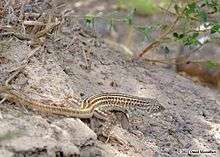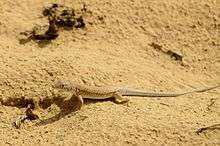Indian fringe-fingered lizard
| Indian fringe-fingered lizard | |
|---|---|
 | |
| Scientific classification | |
| Kingdom: | Animalia |
| Phylum: | Chordata |
| Class: | Reptilia |
| Order: | Squamata |
| Family: | Lacertidae |
| Genus: | Acanthodactylus |
| Species: | A. cantoris |
| Binomial name | |
| Acanthodactylus cantoris Günther, 1864 | |
The Indian fringe-fingered lizard (Acanthodactylus cantoris) is a species of lacertid lizard found in Asia.
Etymology
The specific name, cantoris, is in honor of Danish zoologist Theodore Edward Cantor.[1]
Description
Snout acutely pointed. Four supraoculars; subocular not reaching the lip; temporal scales keeled; front edge of the ear usually rather feebly, but distinctly, denticulated. Dorsal scales strongly keeled, very much larger on the hinder part of the back than between the shoulders and on the flanks, rhomboidal, strongly imbricate; 10 to 16 large keeled scales on a transverse line between the hind limbs. Ventral plates usually broader than long, in straight longitudinal and slightly angular transverse series; 12 or 14 plates across the middle of the body. Usually a median series of broad pre-anals, the posterior largest. The hind limb reaches the ear or the eye. 17 to 23 femoral pores on each side. Digital denticulations strong, usually as long as the diameter of the corresponding part of the toe, much more developed on the outer than on the inner edge of the fourth toe. Upper caudal scales strongly keeled; basal subcaudals smooth or obtusely keeled.[2]

Greyish or buff above, with or without small blackish spots; young with whitish longitudinal lines separated by blackish interspaces with series of round whitish spots, which markings gradually become more indistinct; tail pink in the young.[2]
From snout to vent 2.75 inches (7.0 cm); tail 6 inches (15 cm).[2]
Geographic range
A cantoris is found in eastern Afghanistan, northwestern India (Gujarat, Punjab, Rajasthan, Uttar Pradesh), southwestern Iran, Jordan, and Pakistan.[3]
References
- ↑ Beolens, Bo; Watkins, Michael; Grayson, Michael (2011). The Eponym Dictionary of Reptiles. Baltimore: Johns Hopkins University Press. xiii + 296 pp. ISBN 978-1-4214-0135-5. (Acanthodactylus cantoris, p. 47).
- 1 2 3 Boulenger GA (1890). The Fauna of British India, Including Ceylon and Burma. Reptilia and Batrachia. London: Secretary of State for India in Council. (Taylor and Francis, printers). xviii + 541 pp. (Acanthodactylus cantoris, pp. 70-71).
- ↑ "Acanthodactylus cantoris ". The Reptile Database. www.reptile-database.org.
- ↑ Günther 1864.
Further reading
- Das I (2002). A Photographic Guide to Snakes and other Reptiles of India. Sanibel Island, Florida: Ralph Curtis Books. 144 pp. ISBN 0-88359-056-5. (Acanthodactylus cantoris, p. 103).
- Günther A (1864). The Reptiles of British India. London: The Ray Society. (Taylor & Francis, printers). xxvii + 452 pp. + Plates I-XXVI. (Acanthodactylus cantoris, new species, pp. 73–74).
- Salvador A (1982). "A revision of the lizards of the genus Acanthodactylus (Sauria: Lacertidae)". Bonner Zoologische Monographien (16): 1-167. (Acanthodactylus cantoris, pp. 155–159, Figures 106-108, Map 32).
- Smith MA (1935). The Fauna of British India, Including Ceylon and Burma. Reptilia and Amphibia. Vol. II.—Sauria. London: Secretary of State for India in Council. (Taylor and Francis, printers). xiii + 440 pp. + Plate I + 2 maps. (Acanthodactylus cantoris cantoris, pp. 371–372).